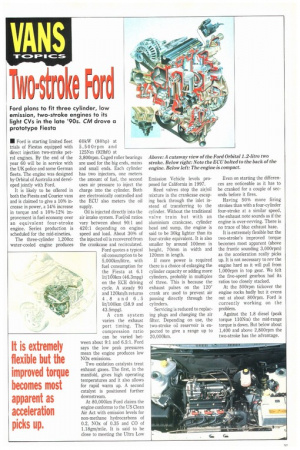Trstroke Ford
Page 39

If you've noticed an error in this article please click here to report it so we can fix it.
Ford plans to fit three cylinder, low emission, two-stroke engines to its light CVs in the late '90s. CM drove a prototype Fiesta
• Ford is starting limited fleet trials of Fiestas equipped with direct injection two-stroke petrol engines. By the end of the year 60 will be in service with the UK police and some German fleets. The engine was designed by Orbital of Australia and developed jointly with Ford.
It is likely to be offered in both the Fiesta and Courier vans and is claimed to give a 10% increase in power, a 14% increase in torque and a 10%-12% improvement in fuel economy over an equivalent four-stroke engine. Series production is scheduled for the mid-nineties.
The three-cylinder 1,200cc water-cooled engine produces 60kW (80hp) at 5,5 0Orpm and 125Nm (921bft) at 3,800rpm, Caged roller bearings are used for the big ends, mains and small ends. Each cylinder has two injectors, one meters the amount of fuel, the second uses air pressure to inject the charge into the cylinder. Both are electronically controlled and the ECU also meters the oil supply.
Oil is injected directly into the air intake system. Fuel/oil ratios vary between about 90:1 and 420:1 depending on engine speed and load. About 30% of the injected oil is recovered from the crankcase and recirculated. Ford quotes a typical oil consumption to be 5,000km/litre, with fuel consumption for the Fiesta at 6.1 lit/1dOkm (46.3mpg) on the ECE driving cycle. A steady 90 and 120km/h returns 4 . 8 and 6 . 5 lit/100km (58.9 and 43.5mpg).
A cam system varies the exhaust port timing. The compression ratio can be varied between about 9:1 and 6.5:1. Ford says the low peak pressures mean the engine produces low NOx emissions.
Two oxidation catalysts treat exhaust gases. The first, in the manifold, gives high operating temperatures and it also allows for rapid warm up. A second catalyst is positioned further downstream.
At 80,000km Ford claims the engine conforms to the US Clean Air Act with emission levels for non-methane hydrocarbons of 0.2, NOx of 0.35 and CO of 1.18gm/mile. It is said to be close to meeting the Ultra Low Emission Vehicle levels proposed for California in 1997.
Reed valves stop the airfoil mixture in the crankcase escaping back through the inlet instead of transferring to the cylinder. Without the traditional valve train but with an aluminium crankcase, cylinder head and sump, the engine is said to be 30kg lighter than its four-stroke equivalent. It is also smaller by around 100mm in height, 70mm in width and 120mm in length.
If more power is required there is a choice of enlarging the cylinder capacity or adding more cylinders, probably in multiples of three. This is because the exhaust pulses on the 120° crank are used to prevent air passing directly through the cylinders.
Servicing is reduced to replacing plugs and changing the air filter. Depending on use, the two-stroke oil reservoir is expected to give a range up to 20,000km. Even on starting the differences are noticeable as it has to be cranked for a couple of seconds before it fires.
Having 50% more firing strokes than with a four-cylinder four-stroke at a similar speed, the exhaust note sounds as if the engine is over-revving. There is no trace of blue exhaust haze.
It is extremely flexible but the two-stroke's improved torque becomes most apparent (above the frantic sounding 3,000rpm) as the acceleration really picks up. It is not necessary to rev the engine hard as it will pull from 1,000rpm in top gear. We felt the five-speed gearbox had its ratios too closely stacked.
At the 500rpm tickover the engine rocks badly but it evens out at about 800rpm. Ford is currently working on the problem.
Against the 1.8 diesel (peak torque 110Nm) the mid-range torque is down. But below about 1,400 and above 2,800rpm the two-stroke has the advantage.
















































































